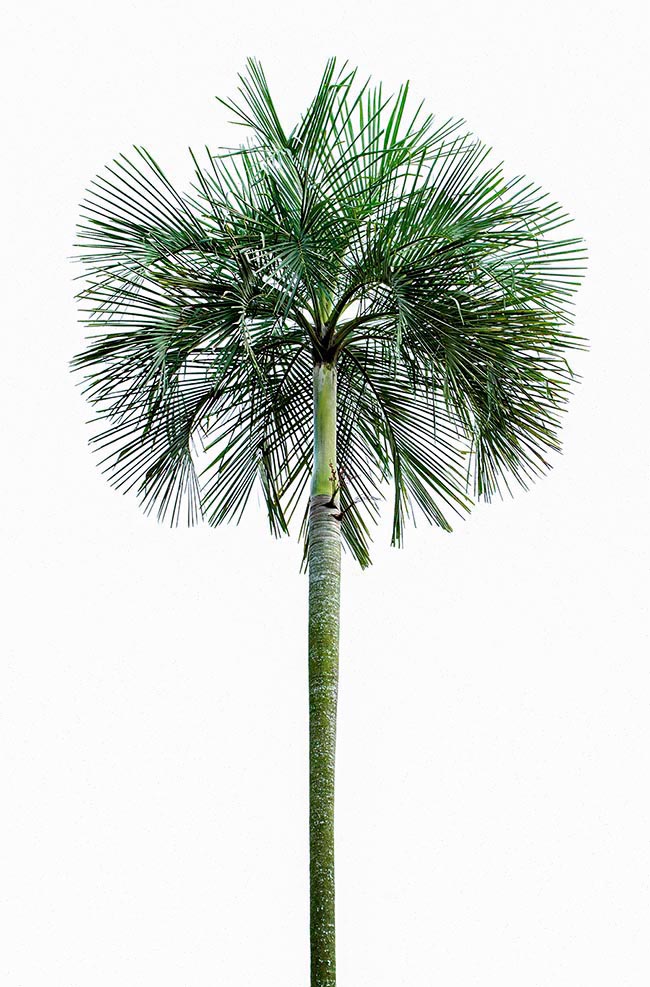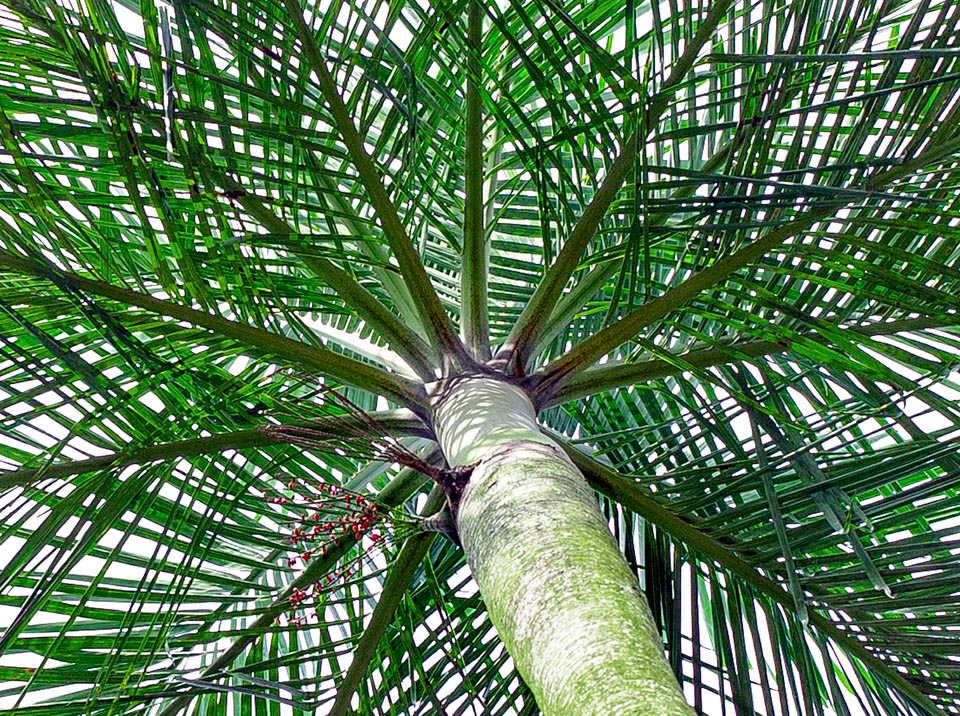Family : Arecaceae

Text © Alessandro Marini

English translation by Mario Beltramini

Native to Solomon Islands, Hydriastele macrospadix can be 40 m tall © Giuseppe Mazza
Hydriastele macrospadix (Burret) W.J.Baker & Loo is native to the Archipelago of the Solomon Islands in southern Pacific, where it grows in the pluvial forests of the plains and the highlands, especially in the Bougainville and Santa Isabel islands.
The name of the genus Hydriastele comes from the Greek prefix “ὕδρο” (hýdro), related to water and from “στήλη” (stéle), column, with reference to the erect and slender stems of the specimens living close to the water.
That of the species macrospadix, comes from the Greek epithets “μακρόϛ” (macrós), big and “σπάδιξ” (spàdix), spadix, with reference to the size of the inflorescence.
Common names: Solomon Nymph Palm (English); Kanana, Kuritu, Niniu (dialects of the Archipelago of the Solomon Islands).
Hydriastele macrospadix is a species with a single stem, straight and thin, that reaches the 40 m of height with a diameter of 25 cm. It is of pale green colour and is marked by the rings corresponding to the scars of the fallen leaves.
The foliar crown, up to 5 m broad, has a spherical form and iw composed by 20-25 pinnate, very arcuate, leaves, of dark green colour, up to 2 m long, supported by petioles of about 50 cm.
The foliar rachis and the petiole are covered by dark brown scales up to the sheath that continues the petiole and wraps completely the stem. The sheath is covered by a thin layer of wax and is about 90 cm long. Of pale green colour tending to whitish, is well visible in the highest part of the stem.
The pinnate leaves are composed by about 30 pinnules regularly arranged on the rachis on two symmetrical levels, forming a V.
The pinnules are lanceolate and rigid, 80-100 cm long and 2,5-3,5 cm broad, of dark green colour above and of glaucous green below and have the truncated and toothed apex leaning down.
Hydriastele macrospadix is a mono-caulescent species. The inflorescence emerges in correspondence of the rings on the stem, under the sheath. It is 50-90 cm long and has 10-25 rachillae. Without peduncular bracts, 25-35 cm long and about 2 mm broad. The rachillas are glabrous, leaning down and bear about 150 triads of flowers, each one comprising one female flower and two males, of red or pink colour.
The bright red fruit has an ovoid shape, it is 6 mm long and 8 mm broad. It contains only one seed presenting a ruminate endosperm, that is, grooved by differently coloured lines.
Hydriastele macrospadix distinguishes from the better known Hydriastele beguinii and from all other species of the genus due to the ruminate endosperm of the seed and for the pinnules having truncated and toothed apex.

The foliar crown, even 5 m broad, is spherical with up to 2 m long very arcuate leaves. The pinnulae are lanceolate and rigid © Giuseppe Mazza
Hydriastele macrospadix is considered as a palm of remarkably aesthetic value and is sought for by botanical gardens and collectors, though still not much diffused in cultivation. It can grow in the tropical, subtropical, and warm temperate climates ones too, where, anyway, the temperature never reaches 0 °C. Conditions of prolonged cold may cause the plant to decline and even to die.
Being native to the rainforests, it loves shady expositions when young, then, once adult, it prefers the full sun. It grows well in acidic to slightly alkaline soil, well drained and constantly maintained humid, because it does not stand drought. It has a discreet tolerance to the sea spray. It reproduces by seed that germinates in 3 to 4 months at the temperature of 26-28 °C. The growth rate is fast.
In its origin islands, the local populations use the stems as boards for floors of the house and as coverings.
Synonyms: Paragulubia macrospadix Burret; Gulubia macrospadix H.E. Moore (Burret).
